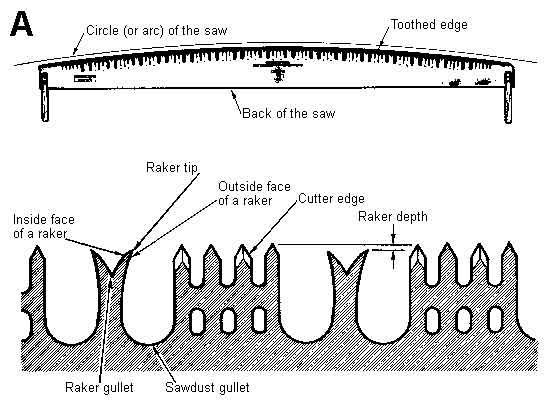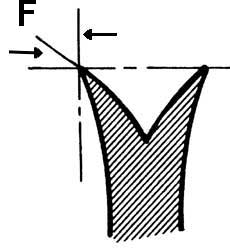Glossary
Back of the saw—(figure A) The edge opposite the toothed edge.
Bevel—(figure B) The bevel of a cutting tooth is the angle the intersection of the two filed surfaces makes with the plane perpendicular to the plane of the saw.
Circle of the saw—(figure A) The toothed edge of most crosscut saws lies on the arc of a circle.
Clearance angle—(figure C) The angle the inside face of the raker tip makes with the direction of saw travel.
Cutter tooth—(figure A) The tooth that scores the wood on each side of the kerf.
Inside face—(figure A) Face of a cutting raker tip that faces the raker gullet.
Jointer—(figure D) Tool used to file the cutter teeth so the tips all lie on the circle of the saw.
Kerf—Slot the saw makes while cutting.
Outside face—The face of a cutting raker tip that faces the sawdust gullet.
Pin gauge—(figure E) Gauge used to determine when the raker has been swaged to the desired depth.
Plane of the saw—The plane that passes through the saw equidistant from both sides of the saw.
Rake angle—(figure F) Angle that the outside face of a raker tip makes with the line perpendicular to the tangent of the saw circle.
Raker—The tooth on a crosscut that clears the shavings from a kerf.
Raker gauge—(figure G) Used to gauge the final raker depth.
Raker depth—The difference in height between raker and cutter teeth.
Raker gullet—The "V" notch in a raker tooth.
Raker face—See outside and inside face.
Raker tip—Supports the cutting edge of a raker.
Sawdust gullet—The gullet between a raker and a cutter tooth.
Set—(figure H) The distance by which the tip of a cutter tooth is bent away from the plane of the saw.
Set anvil—(figure J) A block of metal over which the tip of a cutter tooth is bent when setting.
Set stake—A tool used as an anvil for hammer setting the cutter teeth.
Spider—(figure K) A gauge used to determine when the set is correct.
Swaging—Putting a curve in the outside face of a raker tip, generally by hammering on the inside face.
Parts of a crosscut saw





Rake angle


Set

Set anvils

Spider


